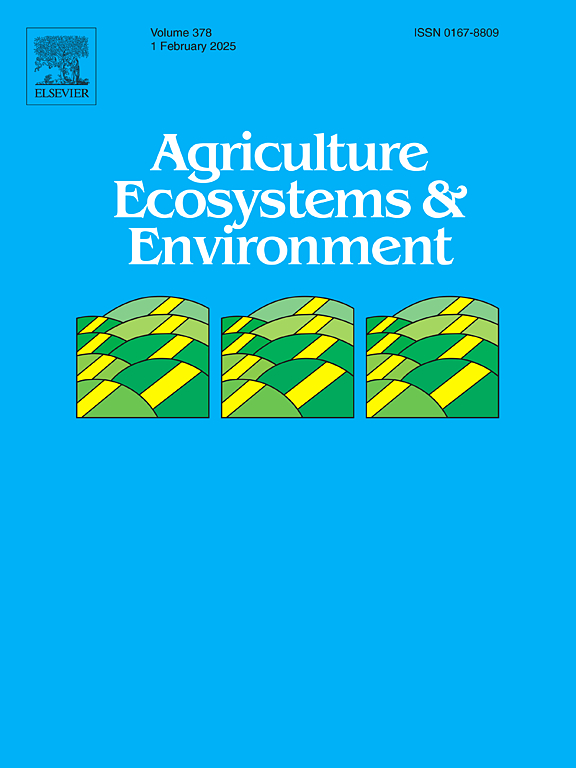The role of red clover (Trifolium pratense L.) in mitigating greenhouse gas emissions: Insights from a temperate agricultural ecosystem
IF 6.4
1区 农林科学
Q1 AGRICULTURE, MULTIDISCIPLINARY
引用次数: 0
Abstract
Agriculture, forestry, and land use contribute approximately 22 % of global anthropogenic greenhouse gas emissions, with nitrous oxide (N₂O), methane (CH₄), and carbon dioxide (CO₂) playing pivotal roles in climate change. This underscores the urgency of adopting sustainable practices such as crop rotation and cover cropping. Red clover, a nitrogen-fixing legume, offers potential for mitigating greenhouse gas emissions by enhancing soil fertility, reducing reliance on synthetic fertilisers, and improving soil health. This study examines the seasonal and management related dynamics of greenhouse gas emissions in temperate agricultural systems and evaluates the short-term and long-term effects of red clover cultivation on soil N₂O, CO₂, and CH₄ fluxes. In addition to crop specific effects, the study identifies key environmental and agronomic factors influencing emission patterns, including soil type, tillage system, farming system, and seasonal temperature and moisture fluctuations. Notably, red clover cultivation initially increased N₂O (7.06 g ha⁻¹ d⁻¹) and CO₂ (137.23 kg ha⁻¹ d⁻¹) emissions due to biological nitrogen fixation and elevated microbial activity, followed by emission fluctuations linked to organic matter mineralisation. In contrast, CH₄ fluxes remained consistently negative, indicating a methane sink effect (-6.54 g CH₄ ha⁻¹ d⁻¹ in year three). These findings highlight the complex interplay between management practices and environmental variables in regulating soil greenhouse gas emissions and underscore the need for further research on biomass contributions to support climate resilient agriculture.
红三叶草(Trifolium pratense L.)在减少温室气体排放中的作用:来自温带农业生态系统的见解
农业、林业和土地利用对全球人为温室气体排放的贡献约为22% %,其中一氧化二氮(N₂O)、甲烷(CH₄)和二氧化碳(CO₂)在气候变化中起着关键作用。这凸显了采用作物轮作和覆盖种植等可持续做法的紧迫性。红三叶草是一种固氮豆科植物,它通过提高土壤肥力、减少对合成肥料的依赖和改善土壤健康,提供了减少温室气体排放的潜力。本研究考察了温带农业系统温室气体排放的季节动态和管理相关动态,并评估了红三叶草种植对土壤N₂O、CO₂和CH _4通量的短期和长期影响。除了作物的特定影响外,该研究还确定了影响排放模式的关键环境和农艺因素,包括土壤类型、耕作制度、耕作制度以及季节性温度和湿度波动。值得注意的是,红三叶草种植最初增加了N₂O(7.06 g ha⁻¹)和CO₂(137.23 kg ha⁻¹)的排放量,这是由于生物固氮和微生物活动的增加,随后与有机物矿化有关的排放量波动。相比之下,CH₄的通量一直是负的,这表明甲烷汇效应(-6.54 g CH₄ha在第三年⁻¹)。这些发现强调了管理实践和环境变量在调节土壤温室气体排放方面的复杂相互作用,并强调了进一步研究生物量贡献以支持气候适应型农业的必要性。
本文章由计算机程序翻译,如有差异,请以英文原文为准。
求助全文
约1分钟内获得全文
求助全文
来源期刊

Agriculture, Ecosystems & Environment
环境科学-环境科学
CiteScore
11.70
自引率
9.10%
发文量
392
审稿时长
26 days
期刊介绍:
Agriculture, Ecosystems and Environment publishes scientific articles dealing with the interface between agroecosystems and the natural environment, specifically how agriculture influences the environment and how changes in that environment impact agroecosystems. Preference is given to papers from experimental and observational research at the field, system or landscape level, from studies that enhance our understanding of processes using data-based biophysical modelling, and papers that bridge scientific disciplines and integrate knowledge. All papers should be placed in an international or wide comparative context.
 求助内容:
求助内容: 应助结果提醒方式:
应助结果提醒方式:


